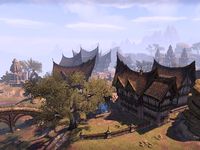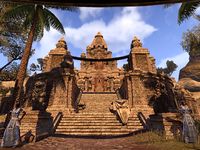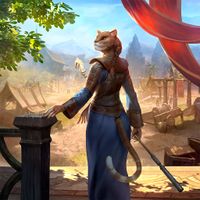Lore:Rawl'kha
| Rawl'kha | |
|---|---|
| Type | Settlement |
| Continent | Tamriel |
| Province | Elsweyr |
| Region | Reaper's March (Jodewood) |
| Appears in | ESO |

Rawl'kha is a Khajiiti city in western Elsweyr, on the border with Valenwood. It is found in the Reaper's March borderlands between the two provinces. It's located on the banks of the Crescent River[1] in northern Jodewood, southwest of Dune. The city is home to Rawl'kha Temple, also called the House of the Dance.[2] Although not the largest, this temple devoted to the Two-Moons Dance is considered to be the most culturally significant Khajiiti temple in northern Elsweyr.[3]
History[edit]
Rawl'kha has been established for many years, as far back as the Merethic Era when it was a part of the Kingdom of Dune. At the high point of the era, the Moon-Priests had significant power over the feudal hunt-lords. This ended when the ruthless hunt-lord Takanzin the Striped Death secretly hired several mercenaries to ransack Rawl'kha Temple and destroy the monks that lived there. The monks attempted to fight back but were annihilated and driven out of Dune by Takanzin's armies. The hunt-lord accused the monks at Rawl'kha of treason, using the incident to suppress other religious orders in ancient Elsweyr.[4]
In 2E 311, the Mane revealed the Riddle'Thar Epiphany at Rawl'kha Temple, a key event in modern Khajiiti theology.[3] By the time of the Interregnum, Rawl'kha was home to the Darkmoon Prowlers, a gang of outlaws who insisted on non-Khajiit members wearing a cat mask.[5]
In 2E 582, the Lunar Champions Khali and Shazah entered Rawl'kha Temple to experience moon sugar-induced visions as part of their trials to become the Mane. This trial was witnessed by the Aldmeri Dominion, with Queen Ayrenn representing the Altmer and the Green Lady Gwaering representing the Bosmer. Rawl'kha was also the center of an archaeological project that year, which sought to excavate ancient battle sites and return the recovered relics and bones in order to strengthen relations between the region's Khajiit and Bosmer populations.[6]
Gallery[edit]
References[edit]
- ^ Name of Crescent River Camp
- ^ The March Explored, Chapter VII — Fenlil the Wayfarer
- ^ a b Rawl'kha Temple loading screen in ESO
- ^ Origins of the Khajiiti Martial Tradition — Tendwuayne, Sapiarch of Foreign Customs
- ^ Rawl'kha Outlaws Refuge loading screen in ESO
- ^ The First Step quest in ESO

